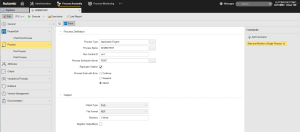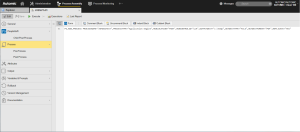PeopleSoft Forms
With PeopleSoft Job objects you can execute PeopleSoft functions directly from within the Automation Engine. For this purpose, Automic delivers Forms, that is, predefined sets of commands that depict those functions. Via the user interface you build scripts for PeopleSoft jobs without having to worry about their exact format.
PeopleSoft Forms are available for version 12.0 SP1 as of January 2017. You can download this Service Pack from Automic's Download Center (click here: Automic Download Center ). For details see XXX.
This topic provides information on the following:
- Background
- Script Editor/PS Form - synchronized views
- Using script variables
- Parameters with default settings
- Combining PS commands with non-PS commands
- Retrieving values
The Automation Engine Script Guide provides detailed descriptions on the syntax of the individual PeopleSoft script elements (commands) here: About PeopleSoft JCL.
Thanks to the integration with PeopleSoft systems, you can execute jobs in PeopleSoft directly from within the Automation Engine.
Your Automation Engine system is connected to PeopleSoft via the agent, which interprets and transforms the commands sent by the client so that PeopleSoft understands them. This means that the only prerequisites your system must meet to be able to create jobs via the Automic Web Interface and execute them in the PeopleSoft client are providing the necessary connection and login data, namely a Login object is available that provides the necessary PeopleSoft credentials (username and password).
Once this prerequisite is met, you just have to build the scripts to be executed. You do so on the Process Page of the PeopleSoft Job object definition.
Given the complexity of PeopleSoft functions, this can be really cumbersome. This is where the PeopleSoft Forms provided by the Automation Engine come into play. They are an additional, intuitive way to build scripts for PeopleSoft jobs using a graphical interface that provides ready-to-use commands.
Synchronized Views - Script Editor/Form
Two views are available on the Process page of PeopleSoft jobs that you can toggle on/off using the buttons at the top of the page:
-
 - Script editor view
- Script editor view -
 - Form view
- Form view
Both views are synchronized. Adding a PeopleSoft command via the Form view means that the corresponding code line is simultaneously written in the Script Editor; if you then populate the fields in the Form, these values are also written to the Script Editor.
Likewise, entering or editing script elements in the Script Editor results in the corresponding modifications in the PeopleSoft Form.
Instead of entering values in the fields of the PeopleSoft Forms you can use variable scripts. This also applies to the Script editor view, of course.
The synchronization of the values you specify for checkboxes and radio buttons is a special case. It is not possible to set their values in a script variable when using the script editor. If you do so, when you save the job, they will be overwritten by the values selected for those checkboxes/radio buttons in the Form view.
Example
You create a script to start and monitor a single process. Using the PeopleSoft Form view you simply add the Start and Monitor a Single Process command to the script designer and enter the values in the command fields:
If you switch to the Script editor view, the script statement looks like this:
Of course, entering or editing script elements in the script editor results in the corresponding modifications in the PeopleSoft Form as well.
Default Settings not Displayed in the Script Editor
Many command parameters have a default value. If you keep the default value when building your scripts, the Script Editor does not display these parameters.
Combining PeopleSoft Commands With Non-PeopleSoft Statements
When building scripts for PeopleSoft jobs you may want to use not only PeopleSoft-specific commands but also the Automic scripting language, for example. You can enter these statements in the Script Editor.
If you do so and then switch to the Form view, non-PeopleSoft commands are grayed out to help you easily recognize them.
Retrieving Values from the Target PeopleSoft System
To be able to retrieve values from the PeopleSoft system with which to populate the input fields, two prerequisites must be met:
- The connection to PeopleSoft must be up an running
- A Login object is available that provides the necessary PeopleSoft credentials (username and password). This Login object is specified in the
APPLICATION_LOGINkey available in the UC_HOSTCHAR_DEFAULT static variable . Its default value isERP_LOGIN. The UC_HOSTCHAR_DEFAULT static variable is supplied with client 0. See UC_HOSTCHAR_DEFAULT - Host Characteristics.
Click the ![]() button where available. This opens a dialog that allows you to search for and retrieve data from the PeopleSoft client and insert it in your scripts:
button where available. This opens a dialog that allows you to search for and retrieve data from the PeopleSoft client and insert it in your scripts:
To Work with the PeopleSoftForm View
![]() To Change the Order of the Commands/Script Elements in the Script
To Change the Order of the Commands/Script Elements in the Script
See also:


